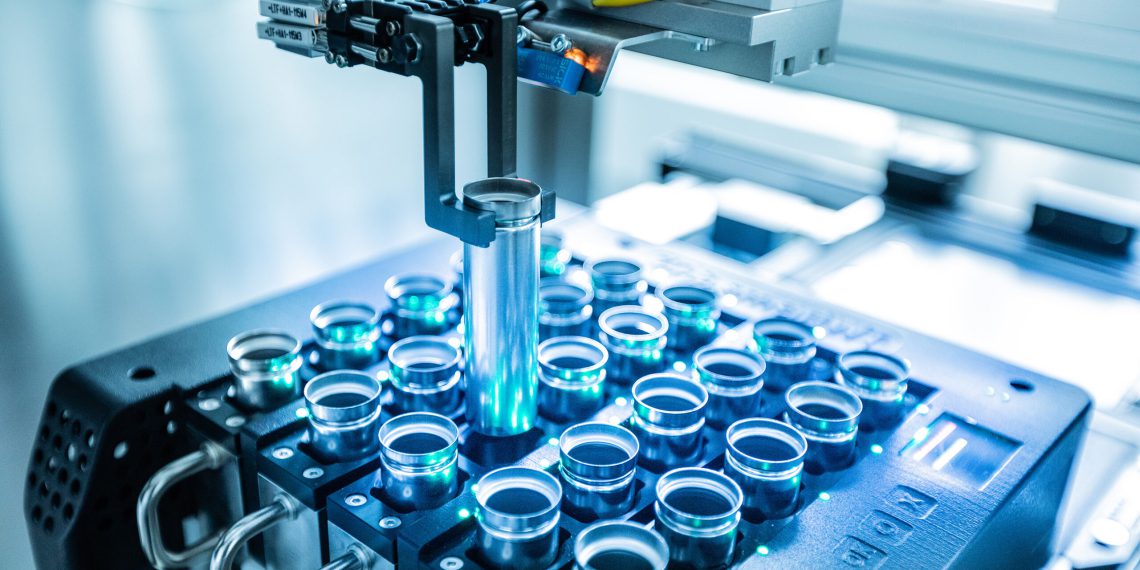The battery is the core of every electric car. It should be compact and as powerful as possible — and above all safe. This places great demands on production. Researchers from Fraunhofer IPA are demonstrating what this could look like in the future at the Center for Digitized Battery Cell Production (ZDB).
A modern battery system couples several battery modules in which a large number of battery cells are installed. Depending on the manufacturer, these cells have a different format. The pilot plant in the ZDB at the Fraunhofer Institute for Manufacturing Engineering and Automation IPA in Stuttgart is designed for cylindrical cell formats.
The electrodes are located inside a battery cell. They consist of wafer-thin coated foils that are rolled up into a coil together with a separator. Even a small defect or a speck of dust that gets inside can significantly weaken the performance or even lead to a short circuit and thus to a fire. At Fraunhofer IPA, therefore, a laboratory with special clean and dry room conditions was created, supported by funding from the state of Baden-Württemberg. It is equipped with plant technology that enables complete assembly of battery cells.
What makes it special is the digitization and networking of all process steps. This provides the researchers with a production line that is unique in Europe, which they can use to support both potential cell manufacturers and machine and plant builders in the development and automation of processes and the optimization of assembly in terms of reliability and throughput. The spectrum ranges from the analysis and investigation of critical process steps to the application of digital tools and prototype construction.
Process monitoring for an optimal solution
Around a dozen steps are required before a cell is ready for use, and each of these steps is crucial for its quality and for that of the entire battery system. The first step is the coating of the positive and negative electrodes, which are then rolled up together with a separator to form a coil, the so-called “jelly roll”. This is followed by assembly. For this purpose, the jelly roll must be guided with high precision and, if possible, without touching the cup wall. The roll is then welded to the base of the bucket by means of a rod electrode inserted through the central hole in the roll. To prevent the wrap from shifting or coming loose, a bead of a specific shape and depth, an annular depression, is incorporated at a defined point.
The next step, the filling of the liquid electrolyte, is particularly delicate and requires an environment without oxygen and with as little humidity as possible. The necessary equipment is therefore located in a hermetically sealed box, a so-called “glove box,” in which it is possible to handle from the outside with gloves worn inside.
“In the process, which takes place under an argon atmosphere, a defined quantity of the liquid electrolyte must be filled in with high precision and without overflowing, because this has an influence on the performance and service life of the cell.”
- Matthias Burgard
This is all the more difficult because the liquid seeps in only slowly because the pore spaces are narrow. Finally, a lid element with a defined joining force is inserted, which is fixed by reshaping the edge of the cup, thus sealing the cell. Due to the desired reliability of the processes, there should be no safety-critical electrolyte on the outside, but the assembled cell is still cleaned before completion. Finally, the cell is wrapped in a protective tube and labeled.
Knowledge from production data converging in the cloud — new knowledge is created
In order to minimize waste and increase quality, researchers led by Florian Maier and Ozan Yesilyurt from Fraunhofer IPA have digitized and networked the entire production process. In a sense, production is becoming transparent. To this end, numerous sensors on all devices collect data that converge in the cloud in real time. Traceability technologies developed at Fraunhofer IPA enable the collected data to be assigned to the battery cells produced. The highlight: Each individual battery cell that is produced is available as a digital twin for data analysis and training of an artificial intelligence. This makes it possible to trace the conditions under which it was manufactured and how it relates to the product quality achieved. Researchers like Soumya Singh are orchestrating this data and using it to develop services with monitoring, analysis and prediction capabilities. This makes it possible to continually optimize the production process and eliminate sources of error more quickly than before.
In addition, the data collected in production also helps to develop better predictive models for the aging behavior of battery cells during use, to evaluate further possible uses for used battery cells and to improve the efficiency of recycling processes. The scientists involved are currently summarizing further approaches to digitizing and data-driven optimization of battery production in the book “Handbook on Smart Battery Cell Manufacturing”. It is due to be published later this year.

















